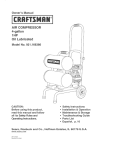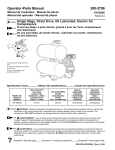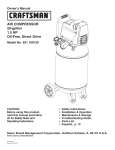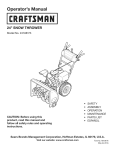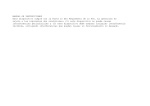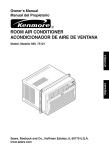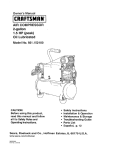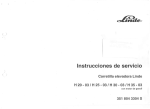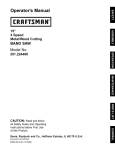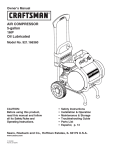Download Craftsman 921.166370 Owner`s manual
Transcript
Owner's Manual lcRnFTSMnN ° AIR COMPRESSOR COt 4-gallon 1HP Oil Lubricated Model No. 921.166370 CAUTION: Before using this product, read this manual and follow all its Safety Rules and Operating Instructions. Sears, Roebuck www.sears.com 3/2112005 Part No, E101375 and Co., Hoffman o • • ° • • Safety instructions Installation & Operation Maintenance & Storage Troubleshooting Guide Parts List Espa_ol, p. 10 Estates, IL 60179 U.S.A. Table of Contents Page Warranty ................................................................................ See Below Safety Symbols ............................................................................ 1 Important Safety instructions & Guidelines .......................................... 1 Specifications 2 Glossary ............................................................................... ................................................................................... 2 Duty Cycle ........................................................................ 2 Parts & Features 3 ..................................................................... Installation & AssembLy ;. ................................................................... 4 Operating Procedures ....................................................................... 5 Detaching Unit from Dolly .............................................................. 6 Maintenance 6 Storage ............................................................................ ............................................................................... 6 Troubleshooting Guide ......................................................................... 7 Exploded View .............................................................................. 8 Parts List .......................................................................... 9 Espa_ot .......................................................................... 10 ONE YEAR FULL WARRANTY ON CRAFTSMAN AIR COMPRESSOR If this Craftsman Air Compressor fails due to manufacturer's defects in material or workmanship within one year of the date of purchase, RETURN IT TO THE NEAREST SEARS STORE OR SERVICE CENTER IN THE UNITED STATES and it will be replaced or repaired (at our option), free of charge,, If this Air Compressor is used for commercial or rental purposes, this warranty applies for only 90 days from the date of purchase, This warranty gives you specific legal rights and you may also have other rights which vary from state to state,, Sears, Roebuck and Co,, Dept, 817WA, Hoffman Estates, IL 60179 Safety Symbols The information listed below should be read and understood by the operator° This information is given to protect the user while operating and storing the air compressor°We utilize the symbols below to allow the reader to recognize important information about their safety** Indicates an imminentlyhazardous situation which, if not avoided, will result in death or serious injury_ Indicates a potentiaIfy hazardous situation which, if not avoided, may result in minor or moderate injury Indicates a potentially hazardous situation which, if not avoided, could result in death or serious injury When used without the safety alert symbol indicates a potentially hazardous situation which, if not avoided, may result in property damage. Important Safety Instructions and Guidelines • Save all instructions Improper operation or maintenance of this product could result in serious injury and/or property damage. Read and understand all of the warnings and safety instructions provided before using this equipment. The air compressor should be operated on a dedicated 15 amp circuit. If the circuit does not have 15 free amps available, a larger circuit must be used. Always use more air hose before utilizing extension cords. Att extension cords used must be 12 gauge with a maximum length of 25 if. The circuit fuse type must be a time delay. Low voftage could cause damage to the motor_ Risk of Moving Parts If the air compressor is in operation, all guards and covers should be attached or installed correctty_ If any guard or cover has been damaged, do not operate the equipment until the proper personnel has correctly repaired the equipment. The power cord should be free of any moving parts, twisting and/or crimping while in use and while in storage° Risk of Burns There are surfaces on your air compressor that while in operation and thereafter can cause serious burns if touched. The equipment should be allowed time to cool before any maintenance is attempted° Items such as the compressor pump and the outlet tube are normalty hot during and after operation° Risk of Falling Operation of the air compressor should always be in a position that is stable. Never use the air compressor on a rooftop or elevated position that could allow the unit to fall or be tipped over. Use additional air hose for elevated jobs° Risk from Flying Objects Always wear ANSI Z87ol approved safety glasses with side shields when the air compressor is in use. Turn off the air compressor and drain the air tank before performing any type of maintenance or disassembly of the hoses or fittings_ Never point any nozzle or sprayer toward any part of the body or at other people or animals,, Important Safety Instructions& Guidelines Risk of Breathing i_._,o _2_: Risk of Electrical Shock I "__ Avoid using the air compressor in confined areas. Always have adequate space (12 inches) on all sides of the air compressor° Also keep children, pets, and others out of the area of operation..This air compressor does not provide breathable air for anyone or any auxiliary breathing device Spraying material will always need to be in another area away from the air compressor to not allow intake air to damage the air compressor filter.. Never utilize the air compressor in the rain or wet conditions. Any electrical issues or repairs should be performed by authorized personnel such as an electrician and should comply with all national and local electrical codes. The air compressor should also have the proper three prong grounding plug, correct voltage, and adequate fuse protection. I .......... ., ..-, .... Risk of Explosion or Fire Risk of Bursting ! ' ....................................... Never operate the compressor near combustible materials, gasoline or solvent vapors. If spraying flammable materials, locate the air compressor at least 20 feet away from the spray area. Never operate the air compressor indoors or in a confined area Always drain the air compressor tank daily or after each use. If the tank develops a leak, then replace the air compressor. Never use the air compressor after a leak has been found or try to make any modifications to the tank. Never modify the air compressor's factory settings which control the tank pressure or any other function.. k Specifications Pump ................................ Oil-lube direct drive Motor .................................... lt0 HP (Induction) Bore ......................................................... 1..65" Stroke ................................................. 1..26" Voltage Single Phase ........................... Minimum Circuit Requirement .................. Air Tank Capacity ................................. Cut-in Pressure ...................................... Cut-out Pressure .................................. SCFM @ 90 PSI ........................................... 120 VAC Oil Capacity ............................... 15 Amps Oil Type .............................. 4 Gallons 95 PSI 125 PSI 2.4 90 mL or 3 oz_ SAE 30 Non-detergent Glossary CFM: Cubic feet per minute. SCFM: Standard cubic feet per minute; a unit of measure for air delivery PSIG: Pounds per square inch gauge; a unit of measure for pressure., ASME: American Society of Mechanical Engineers. California Code: Unit may comply with California Code 462 (I) (2)/(M) (2)., Cut-In Pressure: The air compressor will automatically start to refill the tank when the pressure drops below the prescribed minimum. Cut-Out Pressure: The point at which the motor stops when the tank has reached maximum air pressure° Code Certification: Products that bear one or more of the following marks: UL, ULc, ETL, CSA, have been evaluated by OSHA-certified independent safety laboratories and meet the applicable Underwriters Laboratories Standards for Safety Duty Cycle This is a 50% duty cycle air compressor, Do not run the air compressor more than 30 minutes of one hour.. Doing so could damage the air compressor_ Parts & Features See figures below for reference_ f i Regulator Gauge Offers a quick release feature for Quick Connect attaching and removing the air hose° Indicates the outgoing air pressure to the tool and is controlled by the regulator.. When the pump is not in operation the valve closes to retain air pressure inside the tank..An internal I Check Valve component. 'Tank Pressure Gauge reserve Indicates the air pressure in the tank° L Outlet Tube i Tank Safety Valve Used to allow excess tank pressure to escape into the atmosphere. This valve should only open when the tank pressure is above the maximum rated pressure. Pressure Switch This controls the power to the motor and also the cut-in!cut-out pressure settings. This switch serves as the Auto-On/Off positionsfor the uniL Pressure Relief Valve The pressure relief valve located on the side of the pressure switch, is designed to automatically release compressed air when the air compressor reaches cut-out pressure. The released air should only escape momentarily and the valve should then closer I I I Pressure Relief Tube, I Regulator The air pressure coming from the air tank is controlled by the regulator, To increase the pressure turn the knob clockwise and to decrease the pressure turn the knob counterclockwise., Used to drain condensation from the air tank. Tank Drain Valve Located at bottom of tank. Oil Fill Cap t ., Oil Sight ! eachAir Intake Filter Provides clean air to the pump and must always be kept free of debris. Check on a daily basis or before use. 3 installation & Assembly The air compressor should be turned off, unplugged from the power source, the air bled from the tank and the unit allowed time to cool before any maintenance is performed_ Personal injuries could occur from moving parts, electrical sources, compressed air or hot surfaces. The quick connect assembly must be attached before use. Failure to assemble correctly could result in leaks and possible injury. If unsure of assembly instructions or you experience difficulty in the assembly please call your local service department for further instruction.. Assembly 1. Remove air compressor, handle assembly, hardware, oil bottle, intake filter, manual and accessories from the styrofoam, 2.. Remove the plastic plug from the compressor intake port° (seediagram below) 3.. Install the filter in the compressor intake port° (see diagram below) 4_ Remove the oil fill cap from the crankcase and fill until the oil reaches the top of the red dot in the sight glass. Oil capacity is 3 oz. (seebelow)Use SAE-30 non-deter gent (API CG/CD heavy duty motor oil).. Under extreme cold weather conditions, 32° F (0°C) or below, use SAE-10 weight oil, 5. Replace the oil cap.. 6 Attach the handle to the frame with the saddle bolts from the outside of the handle and the knobs on the inside° Estimated Assembly Time: Approximately 5 minutes Getting Started - Location of the Air Compressor The air compressorshould always be located in a clean, dry and well ventilated environment. The unit should have at minimum, 12 inches of space on each side, The air filter intake should be free of any debris or obstructions,. Check the air filter on a dally basis to make sure it is clean and in working order,. Grounding instructions This product should be grounded. In the event of an electrical short circuit, grounding reduces the risk of electric shock by providingan escape wire for the electric current° This product is equipped with a cord having a grounding wire with an appropriate grounding plug. (See the figure at top right corner,.) The plug must be plugged into an outlet that is properly installed and grounded in accordance with all local codes and ordinances_ Check with a qualified electrician or service personnel if these instructions are not completely understood or if in doubt as to whether the tool is properly grounded_ __ Grounding Pin rounded Gouttet Improper installation of the grounding plug will result in a risk of electric shock,. If repair or replacement of the cord or plug is necessary, do not connect the grounding wire to either flat blade terminal. The wire with insulation having an outer surface that is green with or without yellow stripes is the grounding wire. Check with a qualified electrician or serviceman if the grounding instructions are not completely understood, or if in doubt as to whether the product is properly grounded. Do not modify the plug provided,. If it wil! not fit the outlet, have the proper outlet installed by a qualified electrician. This product is for use on a circuit having a nominal rating of 120 volts and is factory-equipped with a specific electric cord and plug to permit connection to a proper electric circuit. Make sure the product is connected to an outlet having the same configuration as the plug, An adapter should not be used with this product. If the product must be reconnected for use on a different type of electric circuit, qualified service personnel should make the reconnection, Extension Cords Use only a 3-wire extension cord that has a 3-blade grounding plug and a 3-slot receptacle that will accept the plug on the product. Make sure your extension cord is in good condition. When using an extension cord, be sure to use one heavy enough to carry the current your product will draw°Cords must not exceed 25 feet and Noo12 AWG size must be used. An undersized cord will cause a drop in tine voltage resulting in loss of power and overheating_ Break In Procedures No break in procedure is required by the user. This product isfactory tested to ensure proper operation and performance.. Operating Procedures Daily Start-Up Procedures 1. Set the Auto-On/Off lever to the Off position.. 2o Inspect the air compressor, air hose, and any accessories/tools being used for damage or obstruction_ If any of these mentioned itemsare in need of repair/ replacement, contact your local authorized service dealer before use° 3.. Close the drain valve, 4. Check the oil level of the pump. 5. Connect the air hose to the quick connect socket on the regulator assembly by inserting the quick connect plug on the air hose into the quick connect socket°The quick connect socket collar will snap forvJard and lock the plug into place providing an air tight seal between the socket and plug. To release the air hose push the collar back on the quick connect socket. 6 Plug the power cord into the proper receptacle., 7_ Turn the Auto-On/Off lever to the On-Auto position and the compressor will start and build air pressure in the tank to cut-out pressure and then shut off automatically° 8. Adjust the regulator to a PSI setting that is needed for your application and be sure it is within the safety standards required to perform the task_ If using a pneumatic tool, the manufacturer should have recommendations in the manual for that particular tool on operating PSI settings° 9,. The air compressor is now ready for use, The following inflation and cleaning accessories packaged with this unit should only be operated at maximum pressure of 90PSI: blow gun, rubber-tapered nozzle, inflation needles, adapter, and blow gun adapter, ,, ,,,,,,,,,,,,, limit-- Daily Shut-Down Procedures 1. Set the Auto-On/Off lever to the Off position° 2. Unplug the power cord from the receptacle. 3_ Set the outlet pressure to zero on the regulator. 4,. Remove any air tools or accessodes_.When draining the tank, always use ear and eye protection.Drain the tank in a suitable location; condensation will be present in most cases of draining., 5., Open the drain valve allowing air to bleed from the tank° After all of the air has bled from the tank, close the drain valve to prevent debris buildup in the valve.. [ When draining the tank, always use ear and eye protection., Drain the tank in a suitable location; condensation will be present in most cases of draining. Water that remains in the tank during storage will corrode and weaken the air tank which could cause the tank to rupture..To avoid serious injury, be sure to drain the tank after each use or daily.. Detaching unit from dolly For removing, read steps below first before attempting to remove or replace the air compressor to the dolly: Do not use the dolly for any other means other than transporting this air compressor. Do not move air compressor/dolly combo without tightening the knob that safely secures the compressor to the dolly. Removing the air compressor from the dolly: 1_ The air compressor should be turned off and unplugged from the power source_ 2o Turn the knob on the bottom of the dolly counterclockwise until the knob releases from the air compressor, (This should be 1-2 revolutions) 3_ While holding the dolly cart handle with one hand, lift up on the air compressor handle to remove the compressor. Reattaching the air compressor to the dolly: 1., The air compressor should be turned off and unplugged from the power source, 2,, Align the compressors rubber isolators with the depressions in the dolly frame, 3o Insert knob bolt into the air compressor and rotate clock-wise until tight.. (If the compressor is not properly aligned onto the frame the knob will not tighten. Reposition compressor and try again.,) Maintenance NOTE: Any service procedure not covered in the maintenance schedule should be performed by qualified service personnel. The air compressor should be turned off, unplugged from the power source, air bled from the tank and allowed time to cool before any maintenance is performed, items to Check/Change Before each use or daily Check Tank Safety Valve Overall Unit Visual Check X Check Air Filter X : ,== .... X Drain Tank X Check Power Cord for Damage X after first 50 hours Change Oil To ensure efficient operation and longer life of the air compressor unit, a routine maintenance schedule should be followed.The following schedule Is geared toward a consumer whose compressor is used in a normal working environment on a daily basis. Check Oil Level after every 100 hours X Storage For storing the air compressor,be sure to do the following: 1. Turn the unit off and unplug the power cord from the receptacle,, 2. Remove all air hoses, accessories, and air tools from the air compressor, 3o Perform the daily maintenance schedule. 4.. Open the drain valve to bleed all air from the tank. 5. Close the drain valve° 6. Store the air compressor in a clean and dry Iocation_ Troubleshooting Guide The air compressor should be turned off and unplugged from the power source before any maintenance is performed as welt as the air bled from the tank and the unit allowed time to cool. Personal injuries could occur from moving parts, electrical sources, compressed air, or hot surfaces. PROBLEM POSSIBLE CORRECTION Air leaks at the check valve A defective check valve results in a constant air leak at the pressure relief valve or at the pressure relief valve., when there is pressure in the tank and the compressor is shut off. Drain the tank, then remove and clean or replace the check valve_ Air leaks between head and Be sure of proper torque on head bolts, If leak remains, contact a service technician.. cylinder° Air teak from safety valve. Operate the safety valve manually by pulling on the ring. if the valve continues to leak when in the closed position,it should be replaced,. , , ,,,, Pressure reading on the If there is an excessive amount of pressure drop when the accessory is used, regulated pressure gauge replace the regulator, drops when an accessory is used. NOTE: Adjust the regulated pressure under flow conditions (while accessory is being used).. It is normal for the gauge to show minimal pressure loss during initial use of the tool Excessive tank pressure. Move the Auto-On/Off 1everto the Off position.. If the unit doesn't shut off, unplug it from the power source and contact a service technician. , ,,, J, ................ Motor will not starL : Make sure power cord is plugged in and the switch is on, Inspect for the proper size fuse in your circuit box., If the fuse was tripped, reset it and restart the unit,, If repeated tripping occurs, replace the check valve or contact a service technician_ Excessive moisture in the Remove the water in the tank by draining discharge air. environments wig cause excessive condensation. Utilize water filters on your air line, after each use. High humidity NOTE; Water condensation compressor's Air leaks from the tank body or tank welds, air is not caused by compressor output is greater than malfunction.. Be sure the your tool's air consumption rate. Never drill into, weld or otherwise modify the air tank or it will weaken. The tank can rupture or explode. Compressor cannot be repaired. compressor. Discontinue use of the air Air Compressor Parts List Model 166370 Air Compressor Model 166370 Parts List Reference Kit Part Number Number Number 1 E101207 2 3 E100227 Description Fitting,!35 °,3/8"NPT×3!8" ! Compression Screw, Socket Head,M6x I 0 x 30mm 4 CylinderHead Housing, Air lnlakeFilter,DieCast Element,Air Filter Cover,Air Filter t 1 t t 8 Gasket,Head ValvePlate t 2 9 ValveReed 2 4 1 5 1 E100435 6 t Et0tt78 7 2 10 2 11 12 2 13 Et0t113 t4 t5 2 16 17 18 19 20 21 22 Et01137 23 24 25 E100240 26 27 E100098 28 29 7 30 7 31 7 32 E101208 33 8 34 8 35 8 36 37 E100059 38 E100093 39 Reference Kit Part Number Number Number Quantity Gasket,ValvePIate Washer,Lock,6mm Gasket,Cylinder,Upper 1 14 t Cylinder,ID 42ramx H65ram Screw, SHCS,M6x t 0 x 20mm 1 11 Gasket,Cylinder,Lower Motor t 1 Screw, SHCS,M8x 1,25x 16mm Washer,Lock,8mm Washer,Flat,8ram 4 7 7 Nut,Hex,M8x 1,25 Screw, HexFlangeHead,M5x 08 x lOmm Shroud,Plastic Tank 7 6 Washer,Flat,6ram Isolator, Rubber 6 4 Nut,Hex,M6x I8 DrainValve,114" NPT Screw, HexFlange Head, M8x t 25 x55mm PressureReliefTube 4 I 3 Nut,Compression, If4" Ferrule,Compression, 1f4" CheckValve 2 2 t Ferrule,Compression, 3/8" Nut,Compression, 3/8" "[ijbe,Outlet 2 2 1 Coupler,Quick-Connect Regulator PressureGauge,l_5",200PSI 1 1 I Nipple,1t4"NPTx 3" 1 Quantity't ...................... 40 E101348 PressureSwitch 1 4t 42 43 44 E100205 PressureGauge,2",200PSI Nipple,1/4"x 1,5" E100094 Valve, Safety E101340 Power0ord,t4t3 x 6', ST 1 1 I I E10135I 45 46 3 Grip,Handle Eccentric t I 47 3 PistonAssembly t 48 49 50 51 3 3 2, 6 Ring,Scraper Ring,Compression Baffle,Rubber Screw, HexFlange Head, M5x 0.8x15mm I 2 t 6 52 53 54 6 6 4, 6 E100087 Oil FillCap Cover,Crankcase Seal,Oil SightGauge t 1 1 55 56 57 58 59 60 4, 6 Gauge,0i! Sight E101387 HandleAssembly DoilyFrame Nut,Acorn,M12x 1.5 E10t383 Wheel,RedHub E101360 Knob,Removable Dolly 1 1 1 2 2 1 E101377 Isolator,Doily Knob,Handle Bolt,Saddle E101367 Bracket, Retaining forACMEInsert EI00914 lnsert,F!oating ACME, DollyLock E101376 Manual 2 2 2 t t t 6I 62 63 64 65 -- 1 I Description 5 5 Note:Anypart!kit numberfieldwithout a number is notavailable, Descriptions areprovided forreference only,TheKit# columnrepresents thatthepartbeing offered is available ina kit.Oneof eachpartperkitwillbeoffered 1 Kitnumberand partsthat are includedare asfollows: KitNo. PartNo. 1 2 3 4 5 6 7 8 9 E101179 E100959 E100251 E100088 E101397 E101332 E101402 E101403 Description Intake Filter Kit Gasket Kit Piston Kit Sight Gauge Kit Handle Knob Kit Crankcase Cover Kit Pressure ReriefTubeKit Outlet Tube Kit Reference No. 4, 5, 6 7, I0, I2, 15, 50 46, 47, 48, 49 54, 55 62, 63 50, 52, 53, 54, 55 29, 30, 31 33, 34, 35 Contenido P_gina Garantfa ................................................................................................... estap_gina Sfmbolos de seguridad ................................................................ 11 Instrucciones y pautas de seguridad importantes 11 .......................................... Especificaciones ............................................................................ t2 Glosario 12 ........................................................................................... Ciclo de trabajo .......................................................................................... 12 Partes y caractedsticas .................................................................. 13 lnstalaci6n y ensamblaje .................................................................. I4 Procedimientos de operaci6n ................................................................... 15 Para quitar la unidad de ta carretilla ..................................................... 16 Mantenlrniento ............................................................................. 16 Almacenamiento 16 ................................................................................ DiagnSstico y correcci6n de fallas ............................................................ 17 Lista de partes .......................................................................... GARANT|A DE UN AI_O SOBRE COMPRESOR 8 DE AIRE CRAFTSMAN Si este cornpresor de aire Craftsman Ilega a fallar debtdo a defectos de rnanufactura o de rnateriates atribuiblesal fabficante en un plazo de un afio desde la fecha de compra, DEVUt_LVALO A LA TIENDA O CENTRO DE SERVICIO SEARS M_S CERCANO EN LOS ESTADOS UNIDOS para que Ie sea reernp]azado o reparado (a opci6n nuestra) sin ning0n cargo.. Si este compresor de aire se usa con fines comerciales o de renta, esta garanti'a 0nicamente se aplica per 90 (noventa) d[as a partir de la fecha de cornpra, Esta garantfa le da derechos legales especfficos; adem_s, es posible que usted tenga otros derechos, los cuates var[an seghn el estado_ Sears, Roebuck and Co., Dept. 817WA, Hoffman Estates, IL 60179 10 Sfmbolos comunes de seguridad El operador debe leer y entender la informaci6n descrita a continuaci6n. Esta informaci6n se ofrece para proteger al usuario al operar y almacenar el compresor de aire Los sfmbolos siguientes son los que se utilizan para indicar al lector informaci6n que es importante para su seguridado tndica una situaci6n de riesgo inminente que, al no protegerse, provocar& lesiones graves o la muerteo Indica una situaci6n potencialmente peligrosa que, de no evitarse,podrfa provocarlesiones menores o moderadas. Indica una situaciOn potencialmente peligrosa que, al no protegerse, podrfa provocar lesiones graves o la muerte, Cuandono aparezcasin elsfmbolode alertade seguridad,_sto quiere decir que hay una situaci6n potencialmente peligrosa que, al no protegerse,podrfacausar daOosmateriales Instrucciones y pautas de seguridad importantes • Guarde todas las instrucciones o La operaciOn y el mantenimiento inadecuados de este producto pueden provocar lesiones graves y daOos materiales Antes de utilizar este equipo, lea y entienda Ins advertencias e instrucciones de seguridad aquf contenidas, El compresorde aim se debe operar desde un circuito especial de i5 amperioso Si el circuito no dispone de una capacidad de 15 amperios, se debe usar un circuito de mayor capactdad Si es necesado, antes de emplear una extension el_ctrica, aBada una manguera de aire m_s larga_ Las extensiones et_ctricas deben ser de calibre 12 y tener una Iongitud m_xima de 7,6 metros El fusible del circuito debe ser de acci6n retardada_ Un voftajedemasiadobajo puededaOarel motor_ Riesgo por partes en movimiento ................ Riesgo de quemaduras Riesgo de cafda Riesgo de lanzamiento de objetos AI operar el compresor, todos los protectores y cubiertas deben estar fijados e instalados correctamente.. Si alguno de los protectores o cubiertas est,, dafiado, no opere el equtpo hasta que personal calificado repare el problema, El cable de corriente debe mantenerse alejado de las partes mOviles del equipo y no debe torcerse ni prensarse durante su empleo, ni al almacenarse -, ,........ , .............. . En su compresor hay superficies que, at ser tocadas durante y despu_s de su operaciOn, pueden causar quemaduras graves. Antes de darle mantenimiento al equipo, se debe dejar enfriar_ Por Io normal, durante y despu_s de su operaci6n, cierlas partes come la bomba del compresor y el tube de salida estar_n calientes_ El compresor siempre debe ser operado en una posici6n estable_ Nunca utilice el compresor sebre un techo o en una posici6n elevada ya que podrfa caer o volcarse.. AI trabajar en posiciones elevadas, utilice una manguera de aire m_s larga_ AI emplear el compresor, siempre utilice anteojos de seguridad con protectores laterales que cumplan con la norma ANSI Z87Ao Antes de llevar a cabo cualquier clase de mantenimiento y antes de desconectar las mangueras y los acopladores, apague el compresor y drene el tanque de aire. Nunca apunte la boquilla o el rociador hacia ninguna parte de su cuerpo, ni _I de otros seres 11 ............. ' ................ Instrucciones y pautas de seguridad importantes Riesgo para la resplraclon Evite utilizar el compresor de aire en _.reas encerradaso Siempre tenga un espacio libre adecuado (30 cm.) en todos los lados del compresor+ Tambi_n mantenga fuera det _rea de operaci6n a tas mascotas, niOos y otras personas_ Este compresor de aire no provee aire que pueda ser respirado ni empleado con un dispositivo respiratorio auxiliar. El material de rociado siempre deber& estar en otra zona, alejado del compresor de aire, para evitar que el aire aspirado daOe al filtro del compresor_ Riesgo de descargas electricas Nunca utilice el compresor de aire bajo liuvia o en lugares mojados. Los problemas el_ctricos deben ser reparados por personal autorizado, tat como serfa un electricista, y deben cumplir con las normas el_ctricas nacionales y localesoEl compresor tambi_n debe tener la clavija apropiada de tres terminales para hacer tierra y contar con un suministro e!_ctrico que sea de1 voltaje correcto y con un fusible de protecciOn adecuado. Riesgo de explosi6n y fuego Nunca opere el compresor cerca de materiales combustibles, gasolina ni vapores de solventes. Si est_ rociando materiales inflamables, coloque el compresor a una distancia de cuando menos 6 metros del #,reade rociado. Nunca opere el compresor de aire en interiores o en lugares cerrados. Riesgo Drene el compresor diariamente o despu_s de cada utitizaci6no Si el tanque tiene una fuga, reemplace el compresor_ Nunca utilice el compresor si se ha detectado una fuga, ni trate de modificar el tanque. Nunca modifique los ajustes de f_brica del compresor que controlan la presi6n del tanque y dem&s funcioneso de estallido Especificaciones Bomba ...................................... De impulsion directa, lubricada con aceite Motor .................................. ! .0 HP (Inducci6n) Di_metro .............................................. 41.9 mm Carrera .............................................. 32+0 mm Voltaje monof_sico .............................. 120 VAC Capacidad minima del circuito ..................... t5 A Capacidad del tanque de aire ........................... 15.1 litros PresiOn de arranque ................. 655_0 KPa / 95 PSI PresiOn de parada ..................... 861.8 KPa / 125 PSi Piesc0bicos potm[nuto(SCFM)a 90 LPPC.......................... 2.+4 Capacidad del aceite ....................... Tipo de aceite ....................... 90 ml o 3 onzas. SAE 30 - no detergente Glosario CFM: Presi6n de arranque: El compresor arranca autom_ticamente cuando la presiOn baja a menos del minimo prescrito Prest6n de parada: El motor se para cuando el tanque alcance la presiOn m&xima de aire. Certificaci6n de c6digo: Los productos que tienen alguna o varias de las siguientes marcas hart sido evaluados por laboratorios de seguridad independientes certificados por OSHA, y cumplen con las normas de seguridad de Underwriters Laboratories: UL, , ETL, CSA. Pies ct_bicos por minuto SCFM: Pies cubicos est#,ndarpor minuto; unidad de mediciOn de suministro del aireo PSIG: Libras por puigada cuadrada sobre la presi6n atmosfOrica; unidad de mediciOn de presi6no ASME: Sociedad estadounidense de ingenieros mec&nicos, C6digo de California; La unidad puede cumplir con el cOdigo de California 462 (1) (2)/(M) (2)+ Cicio de trabajo Este compresor tiene un ciclo de trabajo de 50%+Nunca opere el compresor por m#,sde 30 minutos cada horao Ya que al hacerlo, podrfa daOarlo. 12 Partes y caracterfsticas Como referencia, vea las figuras abajo. Conector de acopIamiento rdpido Permite conectar y desconectar r&pidamente la manguera del aire, Indica la presi6n de salida del aire que entra en la herramienta, cual que controlada por I Man6metro delapresi6n dees salida .... el regulador, V_lvula de retencidn Cuando la bomba no est_ en operacidn, esta wilvula se cierra para retener la presi6n de aire dentro del tanque, Es un componente interno.. '" Man6metro de presi6n del tanque reserva I..._ Indica la presi6n de la de aire del tanque. Tubo de salida Permite que el exceso de presi6n en el tanque escap_ hacia el medio ambiente. Esta v_tvula s6|o se abrir_ cuandodelaseguridad presi6n en del el tanque I V,_lvula tanqueest6 por encima de la presi6n m_xima nominaldel modelo Controla el suministroel_ctrico en el motor y tambi_n los ajustes de presi6n de arranque y presi6n de paradao Este i tnterruptor de interruptor presi6n sirve como posfci6n de ....autoencendido y apagado (Auto-On/Oft) de la unidad,. Vdlvula de alivio de presi6n Esta v_lvula, que se encuentra en el costado del interruptor de presi6n, est,. diseSada para liberar aire comprimido de manera automdtica cuando el compresor Ilegue a la presi6n de parada El aire s61o deber_ escapar durante un instante, cerr_.ndose la v&Ivula se cerrar_ en seguida. ! ! Tubo de alivio de presi6n Regulador La presi6n del aire que sale del tanque es controlada por et regulador, Para aumentar la presi6n, gire ia perilla en direcci6n de las manecillas; para disminuida, gire la perilla en direcci6n contraria alas manecillas. Sirve para drenar la condensaci6n acumulada en el rondo del tanque_Se encuentra en la parte inferior ! V_lvula de drenaje 1 det tanque. ......... Tap6n de Ilenado aceite Visor Filtro de! aire Suministra aire limpio a la bomba. Siempre debe conservarlo limpio. Revfselo diariamente o antes de cada uso. 13 Instalaci6n y ensamblaje con terminal de tierra (ver la figura a continuaci6n).. La clavija debe enchufarse en un tomacorriente instalado y puesto a tierra seg6n tas normas locales. Hable con un electricista o agente de servicio calificado st no entiende completamente estas instrucciones, o si tiene dudas sobre la correcta puesta a tierra de la herramienta. Antes de darle cualquier tipo de mantenimiento al compresor de aire, se debe apagar y desconectar de la fuente de alimentaci6n el_ctrica, adem_s de purgar el aire deI tanque y darte suficiente tiempo para enfriarse.. Existe el riesgo de que las partes m6viles, las fuentes el_ctricas, el aire comprimido y las superficies calientes provoquen lesioneso El ensamblaje de conexi6n r&pida debe estar instalado antes de usar el compresor. Un ensamblaje inadecuado puede ser causa de fugas y posiblemente de lesiones. Si no est& seguro de entender las instrucciones de ensamblaje o tiene dificultad para llevar a cabo el armado, por favor flame a su departamento local de servicio para obtener m_,s instrucciones.. con "__ Terminal de tlerra Ensamblaje 1..Remueva el compresor de aire, el ensamble de la empufiadura, la ferreterfa, la botella de aceite, el filtro de aire, el manual y los accesorios de la empaquetadura. 2. Remueva el tap6n de pl&stico de la entrada de atre del compresor, (ver abajo) 3. Instale el filtro dentro de la entrada de aire del compreson (vea el diagrama abajo) 4o Remueva el tap6n de Ilenado de aceite, del c_rter del motor y !!_nelo hasta el punto rojo marcade en el vidrio transparenteo La capacidad de aceite es de 90 ml - 3 onzas (vea abajo). Utilice SAE-30 sin detergente (API CG!CD aceite para motores de gran capacidad). Sobre condiciones de temperaturas extremosamente frias, 32° F (O°C) o bajo, utilice aceite muy fluido SAE-10, 5o Coloque nuevamente el tap6n de llenado de aceite. 6.. Fije la empufiadura sobre la estructura con los pernos de cabeza redonda, a partir de la parte exterior de la empufiadura y los recubrimientos en la parte interior. conexi611 a tierra Tomacorrientes Una cenext6n a tierra inadecuada puede provocar una descarga el_ctricao Si necesita reparar o cambiar el cable o la clavija, no conecte el alambre de tierra con ninguna de las terminales planas. El alambre de tierra es de color verde, con o sin franjas amarillaso Si no entiende completamente las instrucciones de conexi6n a tierra, o si tiene dudas sobre la correcta puesta a tierra de la herramienta, hable con un electricista o agente de servicio calificado. No modifique la clavija que viene con el equipo; si no puede enchufarta en el tomacorriente, Ilame a un eIectricista califieado para que le instale el tomacorriente adecuado_. Este producto est,. disefiado para trabajar en un ctrcuito con un voltaje nominal de 120 voltios y est& equipado en la f&brica con un cable y clavija que permiten su conexi6n a un circuito el_ctrico aproplado.. AsegL_rese de que el producto est_ conectado a un tomacorrientecon la misma configuraci6n que la clavija_ No se debe usar un adaptador con este equipo,,Si debe conectar el equipo con un circuito el_ctrico de diferente tipo, consiga la ayuda de personal calificado para realizar ta reconexi6n. Cables de extenst6n $61o utilice un cable de extensi6n de tres alambres con una clavija con extenst6n a tierra de tres terminales que pueda enchufarse en un tomacorrlente de tres orificios.. Asegurese de que su cable de extensi6n est_ en buenas condiciones. Si utiliza un cabte de extensi6n, compruebe que sea de la capacidad de la corriente que requiere su equipo.. Las extensiones no deben ser de m&s de 25 pies (7,6 m) de largo y deben tener cable de calibre 12 AWG. Un cable m_s delgado provocar_, una cai'da en el voitaje de la lfnea, Io que provocarfa una p_rdida de potencia y sobrecalentamlento. Tiempo estimado de ensamblaje: aproximadamente 5 minutos Primer paso: Ubicaci6n de! compresor dei aire El compresor del aire siernpre debe estar en un medio ambiente limpio, seco y bien ventilada La unidad debe tener por Io menos 30 cm de espacio libre en cada lado,. La toma del filtro det aire debe estar limpia y sin ningun tipo de obstrucci6n. For favor revise diariamente el filtro del aire para comprobar que est_ limpio y funcione correctamente.. Instrucciones de conexi6n a tierra Este producto se debe conectar a tierra_ En el caso de que haya un cortocircuito, la conexi6n a tierra reduce el riesgo de descargas el6ctricas al ofrecer una ruta de escape para la corriente el_ctricm Este producto cuenta con un cable que tiene un alambre de tierra y una clavija Procedimiento inicial de preparaci6n No se requiere un procedimiento inicial de preparaci6n. Este producto ha sido probado en la f_.brica para asegurar su operaci6n y rendimiento adecuados. 14 Procedimientos de operaci6n Procedimiento diario de arranque 1o Ponga el interrupter Auto-On/Often la posici6n de apagado (Oft).. 2, Verifique que el compresor del aire, la manguera de aire y todos los accesorioslherramientas utilizados, no tengan dafios ni obstrucci6n,. Si algunas de las piezas descritas requieren raparaci6n/reemplazo, Ilame a su tienda autorizada local de servicio, antes de usar el compresor. 3o Cierre ta v&Ivula de drenaje.. 4_ Revise el nivel de aceite de la bomba. 5.. Enchufe la manguera del aire dentro del conector de acoplamiento r&pido de la unidad del regulador, insertando la clavija de conexi6n r_pida en la manguera de! aire, dentro del conector de acoplamiento r_pido_ El collari'n del conector de acoptamiento r_pido saltar_ hacia adelante, sujetando la clavija y hard una junta entre el conector y la clavija Para desconectar la manguera del aire, empuje hacia atr_s el collarfn del conector de acoplamiento r&p_o. 6_ Enchufe el cable de corriente en un tomacorriente apropiado.. 7.. Mueva el interrupter Auto-On/Off a la posici6n de encendido (Auto-On); el compresor deber_ arrancar, acumulando la presi6n del aire en el tanque hasta Ilegar a ta presi6n de apagado, memento en el cual se apagar_ de manera autom_tica.. 8. Ajuste el regulador a la presi6n de aire recomendada (PSI) para su aplicaci6n, cercior_,ndose de que est_ dentro de las normas de seguridad para ltevar a cabo ta tareao Para las herramientas neum_ticas, el manual del fabricante debe tener recomendactones sobre su presi6n de operaci6n (PSI)., 9+ Ahora el compresor del aire est& listo para ser usado, Los siguientes accesorios de infladoy de limpieza, los cuales vienen con esta unidad, s61o se deben operar a una presi6n m_xima de 90 PSI: soplete, boquilla c6nica de caucho, agujas para inflar, adaptadory adaptador de soplete. Procedimiento diario de apagado 1,, Ponga eLinterrupteren la posici6nde apagado (Of/), Z, Desconecte el cable del tomacorriente< 3.. Ponga en cero el regulador de presi6n de salida_ 4o Desconecte las herramientas y los accesorios. Siempre use protecci6n para los ofdos y los ojos at drenar el tanque. Orene el tanque en un tugar adecuado; en cas¿ redes los cases habr_ presencia de condensaci6n en el drenaje, 5. Abra la v_,lvula de drenaje permittendo que escape el aire del tanque. Cuando haya salido del tanque todo el aire, cierre la v_lvula de drenaje para evitar que entre suciedado AI drenar el tanque utilice protecci6n para ofdos y ojos Drene el tanque en un lugar apropiado; en la mayon'a de las ocasfones al drenar saldr_, condensaci6n. Si no drena el tanque al almacenarlo, en su intedor quedar_, agua que Io corroer_ y debilitar&, Io cual puede provocar su rupturao Para evitar lesiones graves, drene el tanque diariamente o despu6s de cada use, 15 Para quitar ia unidad de la carretilla Para quitarla, primero lea las etapas abajo, antes de intentar quitar o reemptazar el compresor de aire de la carretilia: No utilice la carretilla con otros fines que no sean los adecuados para transportar este compresor de aJre_ No mueva el ensamble compresodcarretilta sin apretar el pomo que fija con seguridad el compresor sobre la carretilla. Para quitar el compresor de la carretilla: 1o Debe apagar y desconectarel compresorde aire de ta fuente de alimentaci6nel_ctrica. 2, Gire e! pomo que se encuentraen la parte inferiorde la carretilia en el sentidocontrario del retoj, hasta que el pomo se desenganchedel compresorde aire (DSle de 1 a 2 vueltas)_ 3. Manteniendoa la vez ta empuSadurade la carretilla con una mano, levante la empuSaduraque se encuentrasobre el compresor,para quitada Para volver a fijar el compresor sobre la carretllla: !. Debe apagar y desconectarel compresorde aire de la fuentede alitnentaciSne!_ctrica 2. Alinee los bioques de aislamientode caucho del compresorcon los huecos de la estructurade la carretitla 3. lnserte el perno con porfio en el compresorde aire y gfrelo en el sentido del reloj, basraque est_ bien apretado. (Si el compresorno est,. alineado adecuadamentesobre la estructura,no podr_ apretar et pomo.Vuelvaa cotocarel compresory h_.galootra vez) Mantenimiento NO'I'A: Cualquier procedimiento de servicio que no est_ cubierto en el programa de mantenimiento que sigue deberd ser efectuado el persona1 de servicio calificado, Asuntos para verificad cambiar Revisar ia v_Ivulade seguridaddet tanque Antes de dar mantenimiento al equipo, se debe apagar y desconectar del tomacorriente, asf como purgar el aire del tanque y permitir que la unidad se enfrfe. Revisar visualmente el aspecto general de la unidad .... A fin de asegurar una operaci6n eficiente y una larga vida del compresor, debe seguir un programa de mantenimiento de rutina.. El siguiente programa de mantenimiento est,. enfocado al consumidor cuyo compresor es usado en un medio ambiente normai y diariamente. Antes de cada uso o diariamente X X , ...,, Revisar el filtro de alre X Drenar el tanque X Vedficar que el cable ef_ctrico no est_ da5ado .... ,,, ...... ,, Cambiar e! aceite Verificar el nivel del aceite . ............... X ........... .......... Despu_sde las primeras 50 horas Despu_sde cada 100 horas Almacenamiento Para almacenar el compresor, asegurese de hacer Io siguiente: 4. Abra la v,_tvula de drenaje para drenar el aire del tanqueo 5, Cierre la v_.lvula de drenaje. 6. Guarde el compresor en un lugar limpio y secoo 1., Apague la unidad y desconecte el cable el,_ctrico deI tomacorriente. 2. Quite del compresor las mangueras, accesorios y herramientas de aire.. 3.. Lleve a cabo el programa de mantenimiento de rutina. 16 Diagn6stico y correccibn de fallas Antes de dar mantenimiento al equipo, se debe apagar y desconectar del tomacorriente,asf como purgar el aire del tanque y permitir que la unidad se enfrfe,, Las partes en movimiento, las fuentes el_ctricas, el aire comprimido y las superficies calientes pueden provocar lesiones. PROBLEMA POSIBLE CORRECCION Fuga de aire en la vdlvula de retenci6n o en la vdlvula de Una v_lvula de retenci6n defectuosa provoca una fuga de aire constante en la alivio_ Drene el tanque, quite y limpie o cambie la v_lvula de retenci6n_ Fugas de aire entre la cabeza fuga, el cilindro Compruebe que los pernos de la cabeza tengan un par apropiado. Si continua la tlame a un t_cnico de servicio. Fuga de aire en la v,=f.lvula Opere manuatmente la v_lvula de seguridad jalando el anillo. Si el tanque continL_a de seguridad teniendo una fuga estando la v_,lvuFa en posici6n cerrada, deber_ cambiarla. La presi6n indicada en el man6metro de presiSn Sial utilizar un accesorio hay una disminuci6nexcesiva de presi6n, cambie el regulador., v_lvula de alivio cuando est_ apagado y el compresor tenga presi6n de aire_ regulada bajar_ cuando se utiliza un accesorio. Ajuste la presi6n regulada bajo condiciones de flujo (mientras se utiliza un accesorio). Es normal que el man6metro indique una disminuci6n de presi6n mfnima al comenzar a utilizar la herramienta. Presi6n excesiva Apague el interruptor de encendido (Off)° Si la unidad no se apaga, descon_ctela del en el tanqueo tomacorriente y comunfquese con un t_cnico de servicioo El motor no arrancao Compruebe que el cable de corrienteest_ enchufado y que el interruptor est_ encendido Compruebeque el fusible de Ia caja de circuitos sea de la capacidadadecuada. Si se ha disparado,restabl_zcaloy w]elva a arrancarla unidad.Si el fusible se disparacon frecuencia, reemplacela v_lvulade retenci6no tlamea un t_cnicode servicio Humedad excesfva en el aire de salida Saque el agua del tanque dren&ndolo despu_s de cada vez que se use En los medios ambientes de alta humedad habr& un exceso de condensaci6n; instale • tros de agua en su Ifnea de aire. La condensaci6n no es provocada por una falla en el compresor. Compruebe que la salida de aire del compresor sea mayor que el consumo def aire de su herramientao Fugas de aire en el cuerpo o la soldadura del tanque Nunca taladre, debilitar_.. suetde El tanque o modifique podffa reparado. 17 de romperse ninguna o explotar, manera el tanque, E1 tanque no pues puede se ser Your Home For repair - in your home - of all major brand appliances, lawn and garden equipment, or heating and cooling systems, no matter who made it, no matter who sold it! For the replacement parts, accessories and owner's manuals that you need to do-it-yourself. For Sears professional installation of home appliances and items like garage door openers and water heaters. 1-800-4-MY-HOME® Call anytime, (1-800-469.4663) day or night (U.S.A. and Canada) .... _,s_c ooj_ _w,s_ca Our Home For repair of carry-in items like vacuums, lawn equipment, and electronics, call or go on-line for the location of your nearest Sears Parts & Repair Center. 1-800-488-1222 Call anytime, day or night (UoS.A° only) www.sears.com_ To purchase a protection agreement (U.SoA.) or maintenance agreement (Canada) on a product serviced by Sears: 1-800-827-6655 (U_S.AJ Para pedir servicio de reparaciSn a domicilio, y para ordenar piezas: 1-888-SU-HOGAR (1-888-784-6427) SM 1-800-361-6665 (Canada) Au Canada pour service en fran(_ais: 1-800-LE-FOYER Mc (1-800-553-6937) w_w_sears_ca ® Registered Trademark/_M Trademark/SM Service Mark of Sears, Roebuck and Co. ® Marca Reglstrada,,' _M Mar,ca de F_,brice] SM Marca de Servic_o de Sears, Roebuck and Co.. MC Marque de commerce! Mu Marque dSposda de Sears, Roebuck and Co, © Sears_ Roebuck and Co,, Sears Canada lnc
This document in other languages
- español: Craftsman 921.166370




















